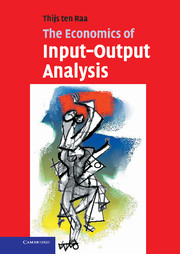Book contents
- Frontmatter
- Contents
- List of figures
- List of tables
- Preface
- Glossary
- 1 Introduction
- 2 Input-output basics
- 3 Multiplier effects
- 4 Linear programming
- 5 Are input-output coefficients fixed?
- 6 The System of National Accounts
- 7 The construction of technical coefficients
- 8 From input-output coefficients to the Cobb–Douglas function
- 9 The diagnosis of inefficiency
- 10 Input-output analysis of international trade
- 11 Environmental input-output economics
- 12 Productivity growth and spillovers
- 13 The dynamic inverse
- 14 Stochastic input-output analysis
- Solutions to exercises
- Index
- References
14 - Stochastic input-output analysis
Published online by Cambridge University Press: 18 December 2009
- Frontmatter
- Contents
- List of figures
- List of tables
- Preface
- Glossary
- 1 Introduction
- 2 Input-output basics
- 3 Multiplier effects
- 4 Linear programming
- 5 Are input-output coefficients fixed?
- 6 The System of National Accounts
- 7 The construction of technical coefficients
- 8 From input-output coefficients to the Cobb–Douglas function
- 9 The diagnosis of inefficiency
- 10 Input-output analysis of international trade
- 11 Environmental input-output economics
- 12 Productivity growth and spillovers
- 13 The dynamic inverse
- 14 Stochastic input-output analysis
- Solutions to exercises
- Index
- References
Summary
Introduction
Thus far, the economy has been given by a set of national accounts with unquestioned precision, but confidentiality, reporting, and measurement problems attach error components to economic data and render the derived constructs – multipliers, (potential) GNP, TFP, etc. – imprecise as well. There are two ways to analyze the transmission of errors. A pure error analysis, without imposition of any stochastic structure, involves the calculation of upper and lower bounds. For example, if GNP is to be determined on the basis of sectoral value-added data, the lower bound would be the sum of the lower bounds of the data and the upper bound of GNP would be the sum of the upper bounds of the sectoral value-added figures. A more interesting way to analyze the transmission of errors is by means of a stochastic framework; the errors are considered random variables, with given probability distributions. The worst-case and best-case scenarios may still occur, but with low probability, because it is unlikely that all (value-added) components assume their lower or upper values simultaneously. Errors tend to cancel out and hence sharper bounds can be derived for the economic variables of interest.
Stochastics
List data or underlying variables listed in vector a, estimated by random variable â with mean E(â) = a and variance V(â). The former locates the levels of the data and the latter measures their precision. List the economic variables of interest in a vector b. They will be a function of the data: b = β(a).
- Type
- Chapter
- Information
- The Economics of Input-Output Analysis , pp. 176 - 182Publisher: Cambridge University PressPrint publication year: 2006



